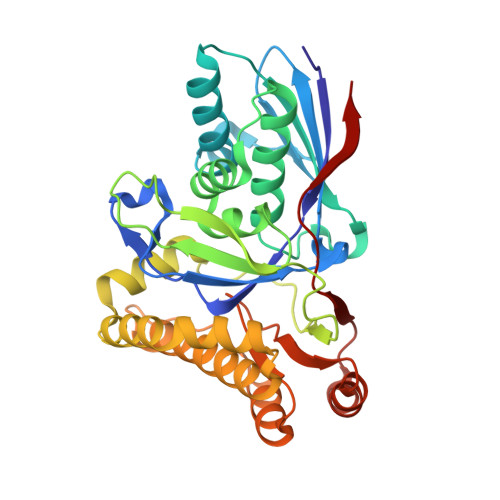A Single Amino Acid Mutation Converts (R)-5-Diphosphomevalonate Decarboxylase into a Kinase
Motoyama, K., Unno, H., Hattori, A., Takaoka, T., Ishikita, H., Kawaide, H., Yoshimura, T., Hemmi, H.(2017) J Biol Chem 292: 2457-2469
- PubMed: 28003359
- DOI: https://doi.org/10.1074/jbc.M116.752535
- Primary Citation of Related Structures:
5GMD, 5GME - PubMed Abstract:
The biosynthesis of isopentenyl diphosphate, a fundamental precursor for isoprenoids, via the mevalonate pathway is completed by diphosphomevalonate decarboxylase. This enzyme catalyzes the formation of isopentenyl diphosphate through the ATP-dependent phosphorylation of the 3-hydroxyl group of ( R )-5-diphosphomevalonate followed by decarboxylation coupled with the elimination of the 3-phosphate group. In this reaction, a conserved aspartate residue has been proposed to be involved in the phosphorylation step as the general base catalyst that abstracts a proton from the 3-hydroxyl group. In this study, the catalytic mechanism of this rare type of decarboxylase is re-investigated by structural and mutagenic studies on the enzyme from a thermoacidophilic archaeon Sulfolobus solfataricus The crystal structures of the archaeal enzyme in complex with ( R )-5-diphosphomevalonate and adenosine 5'- O -(3-thio)triphosphate or with ( R )-5-diphosphomevalonate and ADP are newly solved, and theoretical analysis based on the structure suggests the inability of proton abstraction by the conserved aspartate residue, Asp-281. Site-directed mutagenesis on Asp-281 creates mutants that only show diphosphomevalonate 3-kinase activity, demonstrating that the residue is required in the process of phosphate elimination/decarboxylation, rather than in the preceding phosphorylation step. These results enable discussion of the catalytic roles of the aspartate residue and provide clear proof of the involvement of a long predicted intermediate, ( R )-3-phospho-5-diphosphomevalonate, in the reaction of the enzyme.
Organizational Affiliation:
From the Department of Applied Molecular Bioscience, Graduate School of Bioagricultural Sciences, Nagoya University, Furo-cho, Chikusa-ku, Nagoya, Aichi 464-8601.


















